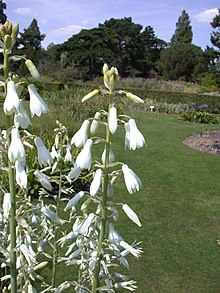Galtonia

Galtonia is a genus of plants in the family Asparagaceae, subfamily Scilloideae. Native to Southern Africa, the genus is named after Sir Francis Galton. According to some authorities it has been subsumed into Ornithogalum as a subgenus, while others prefer to keep it as a separate genus.
These are large, vigorous perennial bulbous geophytes, with numerous wide (>5 cm) and large tapering glabrous leaves that ascend and sheathe the stem. The inflorescences are racemose, and conical or cylindrical, but sometimes corymbose. They bear nodding (rarely erect) flowers with fleshy white or greenish yellow tepals that are fused (rarely free) into a campanulate (bell like) tube that extends about half the length of the flower, but are never fragrant. The bracts are membranous and linear-acuminate, while bracteoles are absent. The pedicels are patent The Stamens, which are hidden amongst the perianth lobes where they are inserted at the base have ovate-acuminate (oval, tapering to a point at one end) filaments that are cylindrical and adnate to the perianth tube, merged at its end (occasionally free). The ovary may be black, green or yellow and or ovoid or cylindrical. The style is filiform (thread like) and white, with a stigma that is glandular and somewhat trilobed.
The fruit capsule is lanceolate, cylindrical or ovate and acute, and wider in its basal third. The capsule is triangular in section with blunt edges and bears seeds that are large and polygonal or irregularly flattened and biseriate. The seed testa is engraved into a puzzle like pattern. The globose bulbs have soft membranous tunics. Chromosome numbers: 2n=16 (12, 14 in G. saundersiae).[3][5]
Galtonia was first described as a new genus within Liliaceae in 1880 by Joseph Decaisne,[1][2] and appeared the following year in the 1881 Kew Gardens report.[6] He describes two species, G. candicans (Hyacinthus candicans Baker[7]) and G. princeps (Hyacinthus princeps Baker[8]), which are listed in an 1884 text.[9] These were reassignments of two of Baker’s species of Hyacinthus, which he distinguished as sufficiently different to justify forming a new genus, with G. candicans the type species.[10]
By the 1870s, as Baker describes in his revision of the family,[11] the taxonomy of Liliaceae had become vast and complicated. Baker had placed the two species of Galtonia, which at that time he considered to be Hyacinthus in the tribe Hyacintheae,[12] one of eight tribes that he divided the Liliaceae into. Later in the 1880s, Galtonia with its two species was included as a district and separate genus in two influential taxonomic systems. In the United Kingdom Bentham and Hooker published their volume on the Liliaceae in Latin in 1883.[13] Bentham and Hooker divided it into 20 tribes and placed Galtonia in the tribe Scilleae with 19 other genera.[14] In the German literature the taxonomic system of Engler completed its classification of Liliaceae in 1888.[15] He divided the family into twelve subfamilies and subordinate tribes. Galtonia was then placed in the subfamily Lilioideae and tribe Scilleae together with 21 other genera. [16]
In 1955 a third species, G. viridiflora,[17] was described, followed by G. regalis in 1986.[18] For a graphical history of its circumscription, see Manning et al. 2009 Table 1.[4] and Martinez-Azorin et al. Table 2.[3] Various efforts were made during the twentieth century to dismember the Liliaceae, culminating in the separation of the higher orders, Asparagales and Liliales, and the emergence of Asparagaceae as a separate family, in which the Scilleae, including Galtonia, were now the Scilloideae subfamily. Galtonia is one of the genera in the tribe Ornithogaleae, the largest tribe within the subfamily Scilloideae.[19] Historically it was treated as part of the subfamily Ornithogaloideae of Hyacinthaceae, now obsolete terms. The preferred treatment being to consider the Hyacinthaceae as subfamily Scilloideae of Asparagaceae.[20][21] The original subfamilies within Hyacinthaceae becoming tribes of subfamily Scilloideae. Thus subfamily Ornithogaloideae became tribe Ornithogaleae.[19][3] The precise taxonomy of the Ornithogaloideae/Ornithogaleae has been problematic since at least the time of Linnaeus.[22][23][notes 2]
